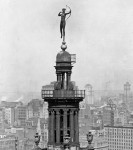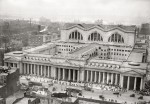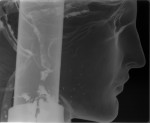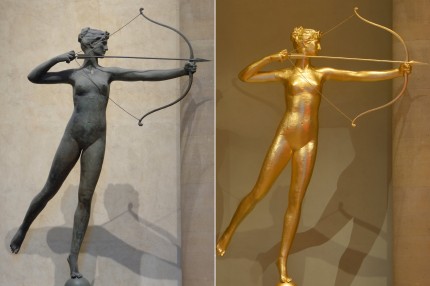 Last summer, the Philadelphia Museum of Art announced a major restoration project to clean, conserve and regild the statue of Diana by Augustus Saint-Gaudens that graces the top of the museum’s Great Stair Hall. The 13-foot statue of the Huntress drawing her bow was made in 1893 to top the tower of architect Stanford White’s Madison Square Garden. Standing on one foot on a spherical base, Diana was originally a weather vane, turning with the wind atop her tower; only later was she riveted to her base for her own safety. She was the tallest point in the city in her day, and shone so brightly that she could be seen from New Jersey.
Last summer, the Philadelphia Museum of Art announced a major restoration project to clean, conserve and regild the statue of Diana by Augustus Saint-Gaudens that graces the top of the museum’s Great Stair Hall. The 13-foot statue of the Huntress drawing her bow was made in 1893 to top the tower of architect Stanford White’s Madison Square Garden. Standing on one foot on a spherical base, Diana was originally a weather vane, turning with the wind atop her tower; only later was she riveted to her base for her own safety. She was the tallest point in the city in her day, and shone so brightly that she could be seen from New Jersey.
Sadly, her fate was tied to that of the building which was demolished in 1925 to make way for the New York Life Insurance Building. New York Life put her in storage hoping she would find a new home in the city, but every attempt to keep her in New York failed and in 1932 she was adopted by the Philadelphia Museum of Art.
 (New York did come to regret its callous rejection of its once-iconic golden lady. In 1967, with the city in the process of building the fourth and last iteration of Madison Square Garden over the graveyard of yet another demolished Beaux Arts masterpiece, the original Penn Station, New York mayor John Lindsay asked Philadelphia mayor James Tate if they could have Diana back to put her inside the new Garden. Tate declined, pointing out that “when no one wanted this poor little orphan girl, Philadelphia took her in, gave her a palatial home and created a beautiful image for her with a worldwide reputation.”)
(New York did come to regret its callous rejection of its once-iconic golden lady. In 1967, with the city in the process of building the fourth and last iteration of Madison Square Garden over the graveyard of yet another demolished Beaux Arts masterpiece, the original Penn Station, New York mayor John Lindsay asked Philadelphia mayor James Tate if they could have Diana back to put her inside the new Garden. Tate declined, pointing out that “when no one wanted this poor little orphan girl, Philadelphia took her in, gave her a palatial home and created a beautiful image for her with a worldwide reputation.”)
After three decades exposed to the elements and seven years in storage, Diana needed some work when she got to Philadelphia. She was in decent condition overall, but her surface was darkened by corrosion and everything but a few traces of the original gilding was gone. In the midst of the Great Depression, the museum had neither the means nor the inclination to regild her. Decades later, in the mid-1980s, the museum did consider regilding Diana, but the time and funding wasn’t there. There was no immediate conservation need since the statue was structurally sound.
 Thanks to the financial support of Bank of America’s Global Art Conservation Project, in 2013 Diana finally got a full makeover. The focus of the project was first and foremost to analyze and document the statue’s surface and structure. The armature, including the weather vane mechanism which still exists inside the spherical base, was examined for condition and to learn more about how Diana was built. Traces of gilding were examined by a scanning electron microscope to determine the exact composition and color of the original gold. The whole statue was X-rayed and subjected to ultrasonic thickness testing to assess the condition of the molded copper sheets Saint-Gaudens soldered and riveted together.
Thanks to the financial support of Bank of America’s Global Art Conservation Project, in 2013 Diana finally got a full makeover. The focus of the project was first and foremost to analyze and document the statue’s surface and structure. The armature, including the weather vane mechanism which still exists inside the spherical base, was examined for condition and to learn more about how Diana was built. Traces of gilding were examined by a scanning electron microscope to determine the exact composition and color of the original gold. The whole statue was X-rayed and subjected to ultrasonic thickness testing to assess the condition of the molded copper sheets Saint-Gaudens soldered and riveted together.
 One the initial observations and tests were complete, conservators cleaned the corrosion, revealing the lovely copper color and the joins. The statue was then primed with a corrosion inhibiting paint containing zinc chromate which left the surface an alarming canary yellow. Thankfully that phase didn’t last long. The statue was then painstakingly covered with 180 square feet of 23.4-karat red gold leaf. Because Saint-Gaudens disliked the use of very bright gold at eye level, the gilding was toned down to match his original intent.
One the initial observations and tests were complete, conservators cleaned the corrosion, revealing the lovely copper color and the joins. The statue was then primed with a corrosion inhibiting paint containing zinc chromate which left the surface an alarming canary yellow. Thankfully that phase didn’t last long. The statue was then painstakingly covered with 180 square feet of 23.4-karat red gold leaf. Because Saint-Gaudens disliked the use of very bright gold at eye level, the gilding was toned down to match his original intent.
The process took five months. In November, the scaffolding came down and Diana was revealed in her freshly gilded splendor. Behold the shiny:
 Visitors to the museum during the restoration got to observe it happening in real time, and the whole process was filmed and shown on screens in the museum. The Philadelphia Museum of Art’s conservation page has two videos illustrating the restoration process. I hope many more will follow because those two are straight awesome.
Visitors to the museum during the restoration got to observe it happening in real time, and the whole process was filmed and shown on screens in the museum. The Philadelphia Museum of Art’s conservation page has two videos illustrating the restoration process. I hope many more will follow because those two are straight awesome.
In this one you see conservators sampling traces of the original gilding, doing cleaning tests before removing the corrosion over the whole statue, doing a boroscopic (self-lit remote camera) examination of interior, opening the ball and removing the bow and arrow.
This video features the steam cleaning done after the acidic cleanser removed the corrosion, the X-ray imaging and ultrasonic thickness testing, and the scanning electron microscope analysis of the gold traces.

Thank you so much for the update! I love this “Diana”!
Doesn’t she look wonderful?
OMG, yes! I was starstruck the first time I saw her in Philly over 30 years ago. Imagine seeing her in person again, all shiny and golden! This update did my heart good!
I prefer sooty to gilded Diana.
I understand. It’s like a copper or bronze patina. It looks lived in and mature.
That was my thought too. I’m not usually fond of shiny, especially gold. I understand why they did it, though, and am happy that they were willing to spend money on restoration.
It is very shiny, and that’s after they mitigated it to suit Saint-Gaudens’ aesthetic.
Keep in mind though that the statue was designed to be seen from a distance. And in time, the weather will “smooth” out the shininess. It’s like the difference between a 19 year old and a 35 year old person.
I take your point
However, I might prefer to look at the 19 year old.
On the other hand, I would rather talk to the 35 year (while looking at her all the while).
… 35 year old …
Since we’re local, my husband and I spent our anniversary at the museum in mid-November. I’m bummed that we missed her big reveal by just a few days. She’s one of my favorite parts of the museum. I guess it’s time for another visit. 🙂
I can only hope that one day Hippolyta will cry out to the gods to give Diana life.
Am I the only one who thinks she looked better before the process was begun? At least from those two pictures.
I completely agree with the logic of the mayor: Philadelphia took her in and and served her well, and deserves to keep her. But she has NOT quite left New York — a smaller version of her by Saint-Gaudens still exists there, in the American Sculpture Courtyard of the Metropolitan Museum.
First of all, thank you livius for making the effort in this marvelous blog, an obvious labor of love shared with others in our emerging global culture.
At first I found all this fascinating – the fact that this girl Diana was getting so much attention and all that after being forgotten for so long. Been following the story of the Philly Diana for decades, being a native of Philly now living in Gotham for close to forty years. Ran into your original article recently about the – about to re-gild story while amateur researching some other forgotten items, lost architectural NYC treasures of that so-called gilded age.
Now in catching up on some modern things such as this recent unveiling of Diana Regilt at the PMA, the thought occurs to me that this is somehow cultural rape of a native Philly Icon. Coming from an old geezer, nobody will care what I think of all this. Considering that Philly bought her as scrap and for the price of scrap at thirty eight dollars, the true re-gilding I would think is in the revisionist art history of her.
I suppose it is only a matter of time before some other philanthropic or publicity starved banking interest puts arms back on the Venus de Milo in the Louvre and why not throw in a nose ring and tattoos while they are at it.
Pax
Well, technically I don’t think you call Diana a native Philadelphian. She’s certainly an adoptive one, though, and much beloved so I take your overall point. Why do you think it’s cultural rape to regild her? The Venus de Milo is missing her arms, but there are a great many ancient statues that were extensively restored, far more so than just adding arms, in the 17th, 18th and 19th centuries. It’s not a practice that conservators use today, but there’s a vast age difference between Venus and Diana. Diana only lost her gold in the past 100 years or so.
Thank you for the kind words about the blog. :thanks:
She was art to me as a little boy over half a century ago with her mere green patina. My POV is that yes she had gilt on the top of MSGII but she was a mere replica of the original bronze piece on top of the too big and too heavy to be a weathervane statue that McKim Meade and White moved to their Agriculture Building at the Columbian Exposition and later lost in the fire of July 1894. The Philly Diana was art as she was salvaged and placed in her niche in the PMA just like the Venus de Milo in the Louvre. Outsiders with money have now decided she wasn’t art unless gilt. Art and beauty are truly in the eyes of the beholder. Now she is too loud in her once quiet niche. “Look at Me!” Maybe a coat of Neon Green Paint to jazz up the natural stones of the PMA main staircase is needed as well. :no: